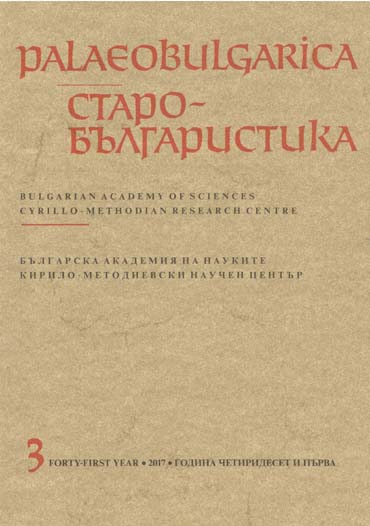Жалки лисици, плашливи еленчета?! Българите планинци според избрани гръкоезични извори от средновизантийския период
Pitiful Foxes, Fearful Fawns?! The Bulgarians as Highlanders According to Selected Greek Sources from the Middle Byzantine Period
Author(s): Kirił MarinowSubject(s): 6th to 12th Centuries
Published by: Кирило-Методиевски научен център при Българска академия на науките
Summary/Abstract: Historians studying the history of Bulgaria in the early Middle Ages, and especially in the period prior to the country’s formal Christianization (seventh–ninth centuries), have led us to view the Bulgarians as a nomadic people comprising horsemen inhabiting the plain around Pliska, Dobruja and the Danubian Plain. There is, of course, much evidence to support this view – to be derived from both written and archaeological sources. However, some scholars argue that in this early period of the khanate’s history the Bulgarians were also engaged in farming and led a more settled life, and there are no doubts as to their sedentary lifestyle with regard to the tenth and eleventh centuries. However, it should be noted that the issue of how they were presented by the Byzantines goes beyond the problem mentioned above. A variety of sources seems to indicate that they were perceived by their southern neighbours as the mountain people, at least to some extent, and Byzantine historians didn’t have a high opinion of highlanders whom they regarded as the embodiment of barbarity. The analysis of a variety of Byzantine sources from the period between the eighth and twelfth centuries leads to the conclusion that the Byzantines saw a strong relationship between the Bulgarians and the mountains they inhabited. Such a view is hardly surprising – Byzantine authors considered Bulgaria a mysterious and dangerous country and, consequently, perceived its inhabitants as mountain people (Outlines of Roman History by Nicephorus, the Life of St. Evaristus, poems by John Geometres), primitive highlanders involved in pastoralism (History by Leo the Deacon), dangerous warriors excelling at all aspects of mountain warfare (Scriptor incertus de Leone Armenio, works by John Geometres, a treatise De castrametatione, History by Michael Attaleiates), haughty and proud people whose character was shaped by the natural conditions in which they grew up (the oration On the Treaty with the Bulgarians). Different pieces of information derived from a variety of Greek sources enable us to complete the Bulgarians’ picture found in sources of the Middle Byzantine period. Given the fact that the tendency to portray the Bulgarians as highlanders continued in the Late Byzantine period (e.g. in the History by Nicetas Choniates), we have reason to believe that the stereotype of the Bulgar-highlander was widespread and became commonplace among Byzantine authors. Such a picture, although it was in part true, branded the Bulgarians with the stigma of savageness, primitivism and belligerence.
Journal: PALAEOBULGARICA / СТАРОБЪЛГАРИСТИКА
- Issue Year: 2017
- Issue No: 3
- Page Range: 63-77
- Page Count: 15
- Language: Bulgarian
- Content File-PDF

